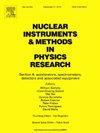在改进快中子能谱的中子散射TOF光谱仪中研究有机闪烁体的光输出特性
IF 1.4
3区 物理与天体物理
Q3 INSTRUMENTS & INSTRUMENTATION
Nuclear Instruments & Methods in Physics Research Section A-accelerators Spectrometers Detectors and Associated Equipment
Pub Date : 2025-06-24
DOI:10.1016/j.nima.2025.170759
引用次数: 0
摘要
中子散射飞行时间(TOF)光谱仪利用两个有机闪烁探测器,与传统的TOF方法相比,可以用更紧凑的设置来表征快中子谱。为了估算入射中子能量En0=Ep + En’,通过对第一个探测器测得的光强进行反演,得到中子散射在氢上产生的反冲质子能量Ep。同时,利用两个探测器之间的TOF测量,确定了散射中子的能量En '。然而,我们的模拟表明,与碳上的中子散射和/或连续多次散射相关的光输出在获取反冲质子能量Ep时可能导致偏差,导致某些测量中子的能量低估和中子谱失真,特别是在低能区域。为探测器设置适当的判别阈值有助于排除与氢上的单中子散射无关的事件,从而提高重建光谱的准确性。通过模拟和实验测量了能量大于5.5 MeV的AmBe源中子的光谱,验证了这种改进。该技术有望以一种相对简单和可靠的方式,方便地测量来自加速器驱动源的能量在10兆电子伏以上的中子。本文章由计算机程序翻译,如有差异,请以英文原文为准。
Investigation of the light output properties of organic scintillators in a neutron-scatter TOF spectrometer for improved fast neutron spectroscopy
The neutron-scatter time-of-flight (TOF) spectrometer, utilizing two organic scintillation detectors, enables the characterization of fast neutron spectra with a more compact setup compared to conventional TOF methods. To estimate the incident neutron energy + , the energy of the recoil proton produced from neutron scattering on hydrogen is obtained by inverting the measured light intensity from the first detector. Meanwhile, the energy of the scattered neutron is determined using the TOF measurement between the two detectors. However, our simulations indicate that light output associated with neutron scatterings on carbon and/or sequential multiple scatterings can cause deviations when retrieving the recoil proton energy , leading to underestimations of the energies for some measured neutrons and distortion of the neutron spectrum, particularly in the low-energy regions. Setting appropriate discrimination thresholds for the detectors helps reject events unrelated to single neutron scattering on hydrogen, thereby improving the accuracy of the reconstructed spectrum. This improvement is verified through simulations and experimentally measured spectra for neutrons from an AmBe source with energies above 5.5 MeV. The technique is expected to facilitate the measurement of neutrons with energies above 10 MeV from an accelerator-driven source in a relatively simple and reliable manner.
求助全文
通过发布文献求助,成功后即可免费获取论文全文。
去求助
来源期刊
CiteScore
3.20
自引率
21.40%
发文量
787
审稿时长
1 months
期刊介绍:
Section A of Nuclear Instruments and Methods in Physics Research publishes papers on design, manufacturing and performance of scientific instruments with an emphasis on large scale facilities. This includes the development of particle accelerators, ion sources, beam transport systems and target arrangements as well as the use of secondary phenomena such as synchrotron radiation and free electron lasers. It also includes all types of instrumentation for the detection and spectrometry of radiations from high energy processes and nuclear decays, as well as instrumentation for experiments at nuclear reactors. Specialized electronics for nuclear and other types of spectrometry as well as computerization of measurements and control systems in this area also find their place in the A section.
Theoretical as well as experimental papers are accepted.

 求助内容:
求助内容: 应助结果提醒方式:
应助结果提醒方式:


